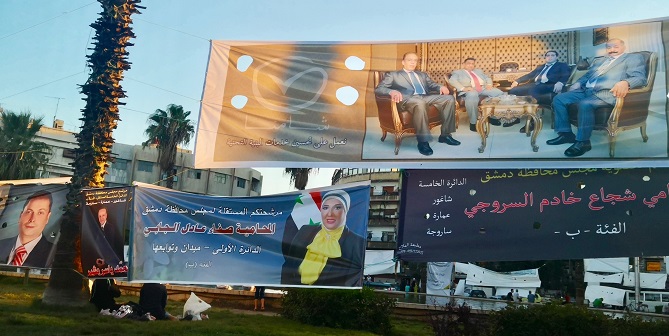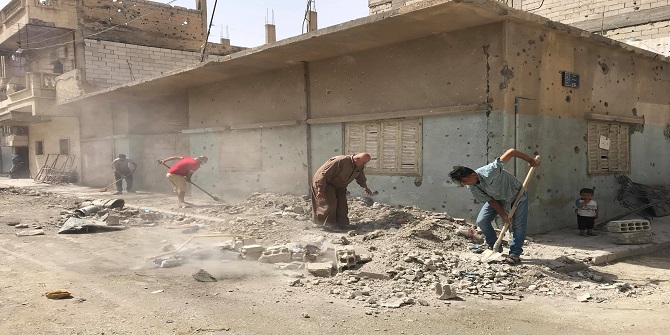
External vision
The non-paper presented in early 2018 by the Syria Small Group (which includes Britain, France, Germany, Jordan, the USA and Saudi Arabia) proposed that the Syrian parliament should consist of two houses. The second house is envisaged to be constructed and constituted upon regional representation “in order to affect the decision making in the central government”. It also discusses the balance of regional interests, and providing clear authorities and guidelines to regional governments according to the principles of decentralisation. In another recent paper by the same group entitled “Principles for a resolution of the Syria conflict,” it is proposed that “Authority should be explicitly devolved and decentralized, including on a regional basis”. Currently there is only one house in Syria, the People’s Assembly.
The idea of having two houses in the parliament in Syria, with one devoted to region-based representation, was never proposed by any political actor in Syria. It first appeared in the Russian-proposed constitution for Syria, which was leaked in mid-2016 and was later handed to the representatives of the opposition in one of the Astana meetings in January 2017. The Russian version suggests a region-based assembly which shares legislative power with the people’s assembly. In addition to legislative power, the region-based assembly would have the power to announce presidential elections, hold no confidence in the government, and ratify international treaties and conventions including agreements granting concessions to foreign companies and issuing general amnesties. It is suggested that the assembly be constituted by representatives of administrative units, but it is not clear whether these representatives would be appointed or elected, nor what election laws would apply.
The Syrian reality
Before 2011, the authority of the Syrian state was very centralised. The state’s distribution of economic and natural resources was very biased and regionally disproportionate. Regions richest in natural resources, like the northeast, received very little back from the centre and had the lowest development indexes in the country. Mayors, as well as all important decision makers in every region, were appointed by Damascus and drew their legitimacy from this appointment and their relations to the power structure in the capital, not from the local population. Ethnic minorities, particularly Kurds, were deprived of their cultural rights and many of them were deprived of other essential rights, including the basic right to a citizenship. The rule of the supposedly secular and Arab Nationalist al-Ba’ath party selectively suppressed the expression of ethnic and sectarian identities, but, in its attempt to co-opt the local population and compensate for its weak legitimacy, it played on identity politics and manipulated tribal, sectarian and ethnic divides.
Seven years of war led to the fragmentation of the state’s centrality and paved the way for the rise of local and regional elites. Some areas went completely outside government control. The northeast is now governed by the Syria Democratic Forces, overwhelmingly controlled by the Partiya Yekîtiya Demokrat (PYD) party, and has extended its control to areas taken from IS like Al-Raqqa. The USA also has a strong influence and presence in the northeast. Within this region Kurds are now freely practicing their cultural rights and have enjoyed more independence. However several reports point out that other minorities in these areas have been subjected to oppressive practices1 and signs of frustration and unrest by Arabs in the areas taken from ISIS are emerging2.
The north-west is divided mainly between two areas. The first one is directly controlled by Turkey, including Afrin which is populated by Kurdish majority. Turkey imposed armed control of Afrin by Arab forces operating outside of Afrin and who have been committing numerous violations against the population. The second area in the north-east (mainly Idlib) is controlled by the armed opposition and extremist groups with significant Turkish influence and armed presence. Although civic local administrative councils were formed in Idlib, decision making is still dominated by warlords and armed actors who have been attempting to mobilise local communities with the use of sectarian rhetorical tools.
Authority has also been fragmented within government- held areas itself, often leading to the rise of regional and local elites. These elites essentially draw their legitimacy from pervasive ethno-sectarian rationalities and their monopolisation and instrumentalisation of violence, as well as their control over the economy. Russia and Iran have also been able to substantially influence decision making within government-held areas, both in the centre and in some of the regions.
Across Syria, mobilisation based on identity has been practiced by nearly all actors especially in relation to violence. Mobilising the youth to join militias became increasingly based on ethnic and sectarian narratives, and external support has played a major role in this sectarianisation process too. Civil society however remained by and large much more resistant to the identity divides.
Decentralisation? Or empowering conflict elites?
All of this leaves many open questions to be answered regarding the proposed region-based representation in Syria.
Syria is in need of decentralisation. It has been discussed widely in policy circles and among Syrians as an answer to many of the structural problems they have experienced and suffered from, both prior to and after the uprisings. But there is yet no consensus among Syrians on the level of this decentralisation. Syrian Kurdish political parties call for a federal Syria, but this is widely rejected by Syrians both on popular and elite levels in areas that do not have Kurdish majority.
This leave us with the question of whether the externally proposed representation on a regional basis in Syria during or just after a conflict is the right level and form of decentralisation that the country needs. The proposal could hold its own set of opportunities, but could also have serious undesired consequences.
Drawing from the experience of other countries where similar systems were adopted post-conflict, there are four main areas of concerns that need to be answered in relation to adopting regional-based representation in Syria. These are:
- Could it possibly further entrench social and societal divides, along ethno-sectarian fault lines, and reward populists who mobilised people during the conflict along ethnic and sectarian lines? Could such a situation trigger more tension and conflict in the future between different areas?
- Could it lead to rewarding warlords and violent elites and the creation of regional tyrants and oppression of the minorities within these regions?
- Could it be an alternative to power sharing? And would such power sharing end the conflict or just shift it to a lower level at multiple sites?
- Could it entrench external intervention and/or nurture and institutionalise local populations’ structural dependency on foreign powers and other nation-states?
Before considering region-based representation in Syria in a new constitution, these questions and many other relevant ones need to be answered to prevent potential encoding of the conflict in the constitution itself which could only lead to further conflicts and instabilities. What Syria needs is a democratisation processes which is protected by the constitution and the law, and which protects the rights of each citizen regardless of which area they live in, and what ethnic or sectarian identity they hold.
A second house dominated by regional elites who emerged during the war could mean a decentralisation of oppression rather than ending the oppression through democratisation processes.
1For example, Amnesty report ‘We had nowhere else to go’: Forced displacement and demolitions in northern Syria’
2 For example: demonstrations in Deir al Zor and in Raqqa
Note: The CRP blogs gives the views of the author, not the position of the Conflict Research Programme, the London School of Economics and Political Science, or the UK Government.





